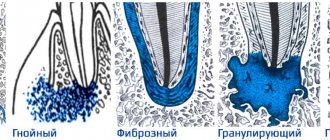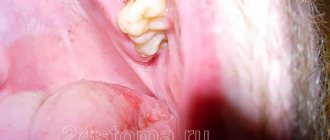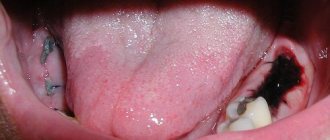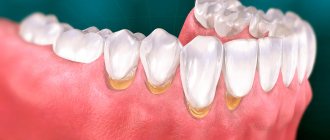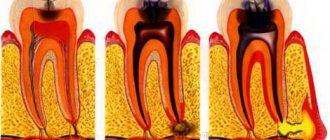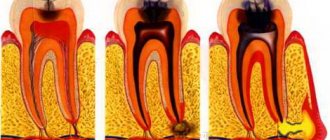Memo to the patient after caries treatment and dental filling.
Today, modern filling materials can last for decades – they are so durable and aesthetically pleasing. However, the service life largely depends not only on professional treatment, but also on the attitude of the patient himself - it is important to have professional teeth cleaning at least once a year, as well as follow some simple recommendations to ensure that the filling lasts as long as possible.
If the filling creates discomfort after treatment
Even in the dental office, after placing the filling, be sure to make sure that the restored tooth does not interfere, i.e. does not overestimate the bite (to do this, you need to create chewing movements of the lower jaw forward and backward, sideways, carefully close your teeth). The filling should not be felt or change the bite. There is no need to be embarrassed to talk about this discomfort to your doctor - sometimes the final stage of filling treatment can take even more time than preparing carious cavities and applying filling material, because The doctor’s main goal is to create multiple contact points between the filled tooth and the antagonist and in no case “turn off” the filling from the bite because this is fraught with changes in the temporomandibular joint.
After treatment, local anesthesia wears off within 1.5-2 hours. If a conductor type was used, then after 4-6 hours. Then you begin to fully feel the restored tooth, you can fully close your jaws and understand how comfortable you are after the treatment.
If you experience a little discomfort, you feel like the tooth is a little higher and your jaw isn't closing quite tightly - this is normal. The fact is that now you have been given a new filling in accordance with the bite, that is, with the shape and position of the antagonist tooth located on the opposite side. Therefore, if there is no sharp pain, be patient for a few days. If the situation normalizes and you get used to it, then there is no reason to see a doctor. If discomfort persists for 1-2 weeks, you should visit your dentist to have the filling corrected.
How much should you not eat after getting a filling?
If a filling made of chemical composites is installed, then you should refrain from eating and drinking for 2 hours. This is due to the fact that the material requires a certain time for final hardening.
If a “light” composite filling is placed, you can drink immediately, but you should abstain from food for 1.5-2 hours. But the reason is not in the material (it hardens a few seconds after applying and polymerizing a special lamp), but in anesthesia - with reduced sensitivity of the mucous membranes during eating, you can injure the mucous membranes of the cheeks and lips.
During the day after the filling is installed, you should only consume foods that are temperature-neutral - excessively hot or cold foods can lead to deformation of the filling. It is necessary to chew food on the opposite side for the first day - this will allow the material to fully “adhere” to the tooth tissues, without the risk of damage.
Dangerous post-filling pain
There are often cases when pain after the installation of a filling serves as a signal of a serious problem that can undermine the patient’s health. Such pain does not go away on its own, regardless of whether you treated caries or pulpitis.
Dangerous pain is associated with infection in the tissue and is characterized by:
- increased pain in the treatment area;
- pain when eating and drinking, even if the food is at room temperature;
- increased body temperature, in some cases - fever and chills;
- swelling of the gums;
- severe swelling and redness of the cheek;
- the appearance of a feeling that the tooth is in the way: it is sticking out, ready to fall out;
- tissue necrosis, which causes a putrid odor in the mouth.
If at least one of the above signs appears, you should seek help from a doctor to avoid complications.
Causes of dangerous pain
Diagnostics will help determine the cause that triggered the development of the infection. In this case, it is important to choose a competent dentist, since in most cases it is the inaccuracy of the examination
leads to
incorrect diagnosis
and the appearance of toothaches.
- Medical error (haste, negligence) includes several sub-reasons that prompted the patient to re-visit the dental office (usually in another clinic and with another specialist), treatment and refilling.
So, these reasons include:
- diagnosis without x-ray.
There is a risk that the doctor will not notice serious problems: for example, inflammation that began in the canals even before treatment. As a result, the treatment will be incomplete: caries is treated, but pulpitis and infected canals remain.
- installing a seal without complying with safety requirements.
This procedure will lead to sharp pain as soon as the anesthesia wears off.
- a filling that is too large or small and disrupts the bite.
At the same time, you need to understand that the shrinkage of any filling, even if selected with the utmost precision, takes time.
If a day or two after the filling the feeling of discomfort (the filling sticks out, puts pressure on the tooth or, on the contrary, settles; the tooth is in the way; it’s uncomfortable/painful to eat) has not disappeared, a re-examination and adjustment of the filling/installation of a new one is necessary.
Breaking off an instrument when cleaning canals is one of the causes of pain
- poor medical treatment of the tooth.
Rushing to prepare a tooth for treatment is fraught with further development of infection. A professional always carefully treats the tooth cavity, even taking into account the complex structure of the canals. Pedantry helps prevent the occurrence and further development of infection.
- drying the cavity.
It is important to properly dry the tooth cavity, because if you don’t dry the walls enough, the filling won’t stick; if you dry it too much, the tooth will become more sensitive.
- overheating of tissues.
The drill operates at high speeds, inevitably heating the treated area. If the doctor does not provide cooling (air and water), the tissues overheat and a nerve burn occurs.
In such a situation, the pain after filling will not disappear, but will develop, leading after some time to pulpitis.
- foreign body in the tooth.
Haste and inattention when working with medical instruments are unacceptable. Otherwise, when filling, a fragment may remain in the cavity. If not removed in time, it provokes severe pain, purulent inflammation, and leads to swelling.
- The second reason is no longer related to the doctor, but to the patient and consists in violating the recommendations.
The main requirement for the patient is not to overload the tooth and not to forget about regular hygiene.
After filling, the doctor explains how to properly care for the treated tooth and the entire oral cavity. In the first two to three days, it is important to take care of the tooth, avoiding strong mechanical impact. You should avoid solid foods (nuts, crackers) and viscous dishes (milk porridge, pureed soups).
After anesthesia, you should refrain from eating, because due to temporary loss of sensitivity, soft tissue can be damaged: cut with hard food, burned with a hot drink.
Itching and redness are some of the signs of an allergy to the composite.
- Allergy to material.
Individual intolerance to the components of the drug can provoke post-filling pain. An allergic reaction usually manifests itself to dyes and preservatives that are part of the filling material. If this is the problem, at the next visit the doctor will select a different filling composition.
Signs of an allergy to a filling:
- soreness;
- swollen gums;
- skin rash, itching;
- asthma attack.
If your tooth hurts after getting a filling
Minor pain may persist for several days or even a couple of weeks, which is explained by overheating of the tissue due to the use of boron, and therefore the preparation is usually carried out with cooling with water. In some situations, for example, with deep caries or when treating front teeth, increased sensitivity can persist even for several months. But in such a situation, you should still consult a doctor for an x-ray to make sure that there is no infected tissue left under the filling and that inflammation has not affected the nerve.
Why a temporary filling is placed: types of material
Non-permanent filling is a mandatory measure in the treatment of complicated carious lesions and root canal inflammation. It is required for medicinal treatment of an inflamed molar or premolar. It is entrusted with the protective function of the treated cavity from food ingress. Also, it prevents the medical pad from falling out.
The composition of such material differs significantly from a permanent filling. It can be made from water-insoluble or plastic components. The choice of the most suitable material directly depends on the condition of the molar or premolar and the purpose of the installation. Among the most common materials are:
- sympath. It can be of different shades - white (for filling non-pulp teeth) or light pink. The mass does not provoke irritation and other allergic reactions;
- dentin paste. It reliably protects the tooth from staining with amalgams and is characterized by water-repellent properties. The paste hardens in 100-120 minutes;
- zinc polyacrylate cement. It is characterized by good biocompatibility with tissues and high strength. The material is used for fixing prostheses (crowns) or filling (both permanent and baby teeth);
- Vinoxol. It is characterized by reliability and durability, capable of maintaining integrity for up to 4-5 months. The drug has antiseptic properties, which allows you to disinfect the tooth cavity. It hardens in 3-4 hours.
There are situations when the carious lesion did not have time to reach the nerve. In such cases, the molar or premolar is not depulped, but temporary material is installed. This is necessary for diagnosis to see whether the tooth will become sensitive or not. With the help of these measures, it is possible to completely preserve a molar or premolar (without removing the nerve) if the patient does not experience pain. If a pronounced reaction occurs (if the temporary filling hurts), the dentist will remove the nerve after placing a filling with arsenic.
Often, non-permanent filling is resorted to during prosthetics. This allows you to protect the molar or premolar from pathogenic microorganisms. The wearing period is individual and directly depends on the type of material and the reason why filling was required. It is installed by the attending dentist. On average, after 7-10, specialists replace it with a permanent filling. Sometimes, after applying a temporary filling, a tooth hurts; let’s figure out what could cause this phenomenon.
Can my gums hurt after filling?
The gums in the area where the anesthesia was administered may ache for several days - this is completely normal and does not require any measures. The mucous membrane may also be slightly inflamed if special rings or matrices were used during treatment, which are placed on the tooth to form the correct shape of its crown and create ideal interdental contact. The gums can also be damaged if the doctor applied the filling material in close proximity to the mucous membrane or even under it - in such a situation, the gums are deliberately moved back, the gums are retracted with a special thread or coagulated. Therefore, pain is a normal reaction to external intervention.
All of these conditions are variations of the norm. But if the pain intensifies, redness and swelling of the mucous membrane progresses, you need to consult a doctor.
Norm or pathology
Let's consider the options for normal and pathological conditions, in which you should immediately consult a dentist.
Is it worth going to the doctor?
It is unlikely that you will be able to correct the situation on your own without qualified help. Therefore, if the filling interferes, you need to contact your dentist.
Many people, when faced with such a problem, try not to pay attention and wait for the material to erase itself. This opinion is erroneous, since modern dental preparations used for filling have high strength values. Therefore, it can take years for abrasion to occur.
The opinion regarding shrinkage over time is correct, but until this happens, a significant period of time may pass. It is impossible to get used to unpleasant symptoms, and keeping the jaw in this state for a long time can lead to negative consequences.
How to properly perform hygiene procedures
After treatment, brush the filled tooth carefully, applying minimal pressure to it. Do not use rinses containing abrasive substances and alcohol, which can increase the plasticity of the material - this will lead to a change in the shape of the filling. Also, do not use overly hard brushes - they can leave microcracks in the material, which will not have the best effect on the durability of the filling.
In general, you should take care of teeth with fillings in a completely standard way:
- daily brushing of teeth twice a day - in the morning after breakfast and in the evening after all meals, after - rinsing the mouth with water and rinse,
- To clean the area of filled teeth after eating, it is better to replace dental floss with an irrigator. If you floss (thread) carelessly, you can touch the installed filling, especially if there are thin edges of the tooth, which will lead to its chipping or loss.
Possible consequences
If the installed filling material interferes with the full closing of the mouth and jaw closure, this is fraught with side effects for the patient.
The consequences may be as follows:
- Pressure on antagonist teeth. If the product is not installed correctly, the adjacent teeth will exert constant pressure on the filled unit. It can provoke periodontal trauma and the development of secondary caries.
- Formation of cracks and chips on the surface. Excessive pressure can not only cause injury, but also lead to chipping. In addition, weak tooth walls can break off along with the filling.
- Dislocation of the jaw. Incorrectly installed elements can cause insufficient jaw closure. Misalignment of one part in relation to the other will lead to dislocation.
Is it necessary to follow a diet after caries treatment?
From the diet as a whole after caries treatment (especially if a large filling is installed and your own tooth has very thin walls), it is recommended to remove too hard foods - toffees, chewing gum, grilled fruit, nuts, etc. Or chew them with teeth located on the opposite side (if they do not have fillings).
Minimize the amount of consumed foods and drinks that contain coloring pigments (tea, coffee, beets) - under their influence, the filling material may slightly change its shade. This rule is especially relevant when restoring front teeth.
How to maintain your treatment guarantee
To maintain the guarantee, the patient must strictly follow all recommendations: do not overload the tooth, do not use it for other purposes (for example, opening beer bottles, biting off threads), and also regularly see the doctor in accordance with the individual schedule of medical examinations, approximately once every six months. Unfortunately, many patients forget about this, and it is the last point that is the key to maintaining the guarantee for treatment.
You need to visit a doctor 1-2 times a year. During a preventive examination, the dentist will be able to make sure that the filling is in good condition, and that secondary caries does not develop again under it.
Check yourself: when to see a doctor
If a tooth hurts 2-3 days after the filling is placed, and the pain noticeably intensifies when pressed at night, this may indicate a relapse of caries and damage to the dental nerve. If black spots are visible under the filling several months after treatment, the filling interferes with the closure of the jaws or there is prolonged pain when pressing on the tooth. Do not ignore these symptoms and do not be afraid - this is a reason to contact your attending physician - all work must be carried out within the framework of the guarantee of the medical institution. Timely treatment is the key to the health of your teeth!
What will the dentist do?
First of all, the doctor will perform repeated manipulations to process the product using a copy napkin. After applying it to the tooth, the patient will need to clench his jaw tightly. The interfering area is determined by the imprints left on the surface of the unit.
If the cause of the pain is periodontal disease, a periodontist is involved in the treatment process, who, together with the therapist, works to eliminate the problem.
In some cases, removal of the filling may be indicated. After preparing the dental unit, medicinal substances are placed in it, as well as an insulating lining. Then a temporary filling is installed and the patient is sent home. If after a second visit the dentist notices an improvement, a permanent product is installed.
